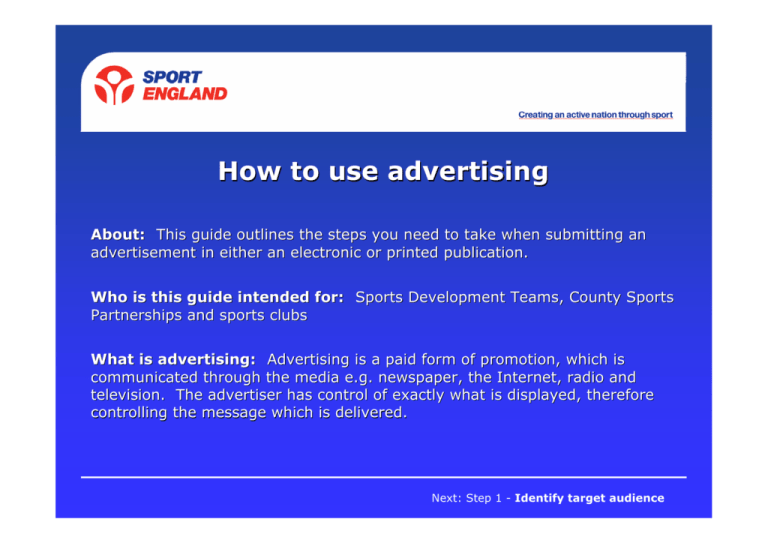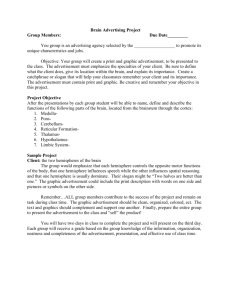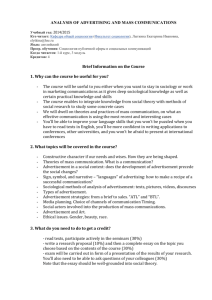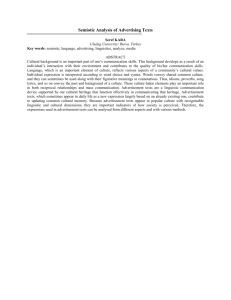NEY MARKETING YOUR CLUB How to create an advert
advertisement

How to use advertising About: This guide outlines the steps you need to take when submitting an advertisement in either an electronic or printed publication. Who is this guide intended for: Sports Development Teams, County Sports Partnerships and sports clubs What is advertising: Advertising is a paid form of promotion, which is communicated through the media e.g. newspaper, the Internet, radio and television. The advertiser has control of exactly what is displayed, therefore controlling the message which is delivered. Next: Step 1 - Identify target audience 1. Identify your target audience Identify and analyse the target audience of your advertisement. Understanding your target audience will assist you in determining the style and message and where to place your advertisement. Check out Sport England’s segmentation profiles and the Active People Survey to assist you with this. Segmentation Profiles: http://promotingsport.sportengland.org/howtoguides Active People Diagnostic: www.webreport.se/apd Next: Step 2 - Define the aim of advertisement 2. Define the aim of advertisement What do you hope to get out of advertising? Determine your aim; whether it’s increasing club membership, promoting a particular service or event, or trying to change a particular behaviour or perception. Ensure there is only one aim for the advertisement. Next: Step 3 - Determine advertising budget 3. Determine advertising budget The amount of money you have to spend on an advertisement will help you determine which advertising channel to use. Print advertising need not be expensive. Advertising within a local paper, who has a large circulation, is a cost effective way of reaching large numbers of people within the local community. Next: Step 4 - Choose appropriate advertising channel 4. Choose appropriate advertising channel Select the best ‘vehicle’ to deliver your message. When making your decision analysis which method will best reach your target audience e.g. local paper or specific website. Specialist magazines offer a more targeted readership, but may not attract local interest. Local newspaper offer the opposite to this. Next: Step 5 - Choose the advertisement type 5. Choose the advertisement type Print adverts come in two types - run of paper (ROP) and classified. Ask yourself the question – will I achieve my goal with one big advert, or a series of small ones? ROP adverts appear at random where ever there is space. They are usually designed in colour to attract the unwary eye amongst the general editorial. This is a good method for catching the attention of the general browser. Classified adverts appear together at the back of the paper under specific subject headings. This is a good method for catching the attention of readers who are looking for specific events. Daily papers offer a range of reader profiles depending on the day. The ‘jobs’ day is usually the most widely read, with ‘property’ and the weekend papers not far behind. Next: Step 6 - Obtain advertising specification 6. Obtain advertising specification Obtain details from the chosen publication in relation to the advertisement’s placement, size, colours and how and when they need it supplied. Ask the publisher if there is a charge for laying out the advert. Ask yourself if you need full colour, or could you save money with black and ‘spot’ colour. Next: Step 7 - Create advertising message 7. Create advertising message Establish the main selling point you want to portray in your advertisement. Analysis of what your target market value will assist you in establishing this message e.g. for males aged 18-25 promote the club as as a social place where you can play with your mates. Sporting association logos can inspire confidence especially when parents are choosing activities for their children. However, too many can distract from the message. Next: Step 8 - Write the copy 8. Write the copy The headline is critical as it may be the only part of the advertisement that people read. It must grab the reader’s attention and make them want to read on. The body copy should consist of an introductory statement, explanatory paragraphs and a closing paragraph. Consider using the following pattern when writing body text: 1. 2. 3. 4. Identify a specific desire or problem for the target audience; Suggest how you can satisfy the desire; State the advantages and benefits of your product or service; Outline what action the reader needs to take e.g. phone, website or email address. Next: Step 9 - Insert Artwork and brand 9. Insert Artwork and brand Artwork can consist of photographs, illustrations, graphs, charts or tables. They are used to attract attention, and to encourage the audience to read the copy. It also allows you to communicate an idea that is hard to put into words. The following link will take you to an extensive library of sports images, which you will be able to use within your advertisements: http://promotingsport.sportengland.org/Extra pages/Photo library An example of an print advertisement follows… Next: An example advert An example advert Want some dirty fun? Holme Valley Harriers will give you the run of your life up hill and down dale. Headline Body Text Open night on Thursday November 3 – 6pm-9pm Scout Hall Netherthong. All Welcome! Artwork Action For more information contact Holme Valley Harriers or visit www.holmevalley.co.uk Logo Next: Check list Check List 1 Who is your target audience? 2 What is the aim of your advertisement? 3 What is your budget? 4 Where will you place your advertisement? 5 What are the specifications of your advertisement? 6 What is your advertising message? 7 Does your headline grab the readers attention? 8 Does your body copy state the advantages and benefits of your product/service? 9 Is it clear what action the reader must take? Next: Further reading Further Reading Active People Survey How to work with design agencies Appropriate case studies






